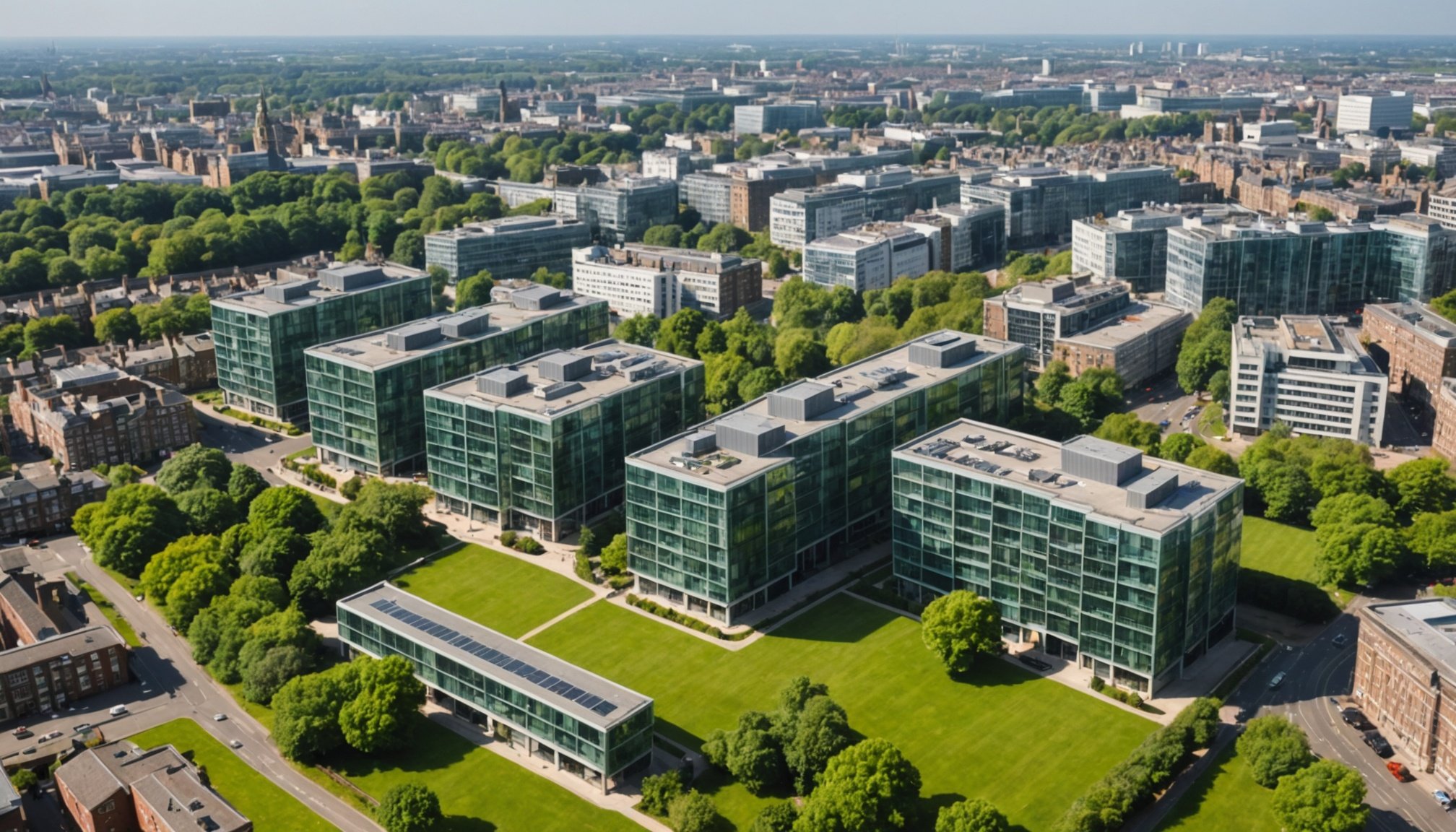Unlocking Sustainable Real Estate Financing in the UK: The Role of Green Bonds
As the world grapples with the challenges of climate change, the need for sustainable financing solutions has never been more pressing. In the UK, one of the most promising avenues for achieving this goal is through the use of green bonds, particularly in the real estate sector. This article delves into the role of green bonds in unlocking sustainable real estate financing, exploring their mechanisms, benefits, and the broader impact on the built environment.
What are Green Bonds?
Green bonds are a type of financial instrument specifically designed to raise capital for projects that have a positive environmental impact. These bonds are issued by companies, governments, or other entities to finance initiatives such as renewable energy projects, energy efficiency improvements, sustainable buildings, and other environmentally friendly ventures.
Topic to read : Smart solutions for maximizing space in small commercial properties throughout the uk
Key Components of Green Bonds
To ensure the integrity and effectiveness of green bonds, several key components are crucial:
- Use of Proceeds: The funds raised from green bond issuances must be clearly allocated to eligible green projects. For example, HSBC’s Green Bond Framework specifies that proceeds are used for projects such as renewable energy, energy efficiency, and sustainable buildings[1].
- Project Evaluation and Selection: A rigorous process is in place to evaluate and select projects that align with the issuer’s sustainability policies. Citi’s Green Bond Framework, for instance, involves a review by the Environmental and Social Risk Management (ESRM) team to ensure projects meet the eligibility criteria[3].
- Management of Proceeds: The proceeds from green bonds are managed separately from other funds to ensure they are used as intended. This includes tagging green assets within the financial management system[3].
- Reporting: Regular reporting is essential to provide transparency on the use of proceeds and the environmental impact of the projects. Citi, for example, publishes an annual green and social bond report detailing the assets funded and their environmental impacts[3].
The Impact on Real Estate Financing
Green bonds are revolutionizing the way real estate projects are financed, particularly in the UK where there is a strong focus on reducing carbon emissions and achieving net zero.
In parallel : Finding harmony: effective approaches to boosting community and business in mixed-use developments
Green Buildings and Energy Efficiency
One of the primary areas where green bonds are making a significant impact is in the financing of green buildings and energy efficiency projects. These bonds enable developers to secure capital for constructing or retrofitting buildings with sustainable features such as green roofs, advanced insulation, and renewable energy systems.
For instance, HSBC’s green bond issuances have supported a significant portion of projects related to green buildings and energy efficiency. As of June 2024, 35% of the allocated funds from one of their green structured bonds went towards efficient (green) buildings[1].
Market Resilience and Growth
Despite various economic and political headwinds, the market for green bonds has shown remarkable resilience. In the first nine months of 2024, sustainable bond issuance increased by 8%, with green bond issuance reaching its strongest level since records began in 2015[2].
This growth is indicative of a broader trend where investors are increasingly seeking out sustainable investment opportunities. As Hannah Simons, Head of Sustainability at Lloyds Bank Corporate Markets, noted, “A healthy sustainable bond market means more companies must clearly articulate how they will use the proceeds of bonds to deliver a real-world impact”[2].
Regional and Global Perspectives
The use of green bonds in real estate financing is not limited to the UK; it is a global phenomenon with various regions contributing significantly.
EMEA and Asia Pacific
The EMEA region has been particularly active in sustainable bond issuance, accounting for 53% of the total issuance in the first nine months of 2024. Asia Pacific also plays a crucial role, with countries like Australia and Singapore seeing significant activity in green bond markets[2].
UK’s Leadership in Green Finance
The UK is at the forefront of green finance, with initiatives such as the European Green Bond Standard set to apply from the end of 2024. This standard will introduce a voluntary label for issuing green bonds, enhancing transparency and credibility in the market[2].
As Paul O’Connor, Head of EMEA Sustainable Finance at JP Morgan, emphasized, “Hopefully we’ll see the UK continue to take the lead in working out how to finance the green transition under its new government. Ultimately what we’re doing doesn’t matter unless there’s policy support”[2].
Practical Insights and Actionable Advice
For those looking to leverage green bonds in real estate financing, here are some practical insights and actionable advice:
Aligning with Sustainability Policies
- Ensure that your projects align with the sustainability policies of the bond issuer. For example, HSBC’s Green Bond Framework requires projects to adhere to their sustainability policies, which include criteria for renewable energy, energy efficiency, and sustainable buildings[1].
Transparent Reporting
- Maintain transparent reporting to demonstrate the use of proceeds and the environmental impact of the projects. This builds trust with investors and stakeholders. Citi’s annual reports provide detailed information on the assets funded and their environmental impacts[3].
Diversifying Investment Portfolios
- Consider diversifying your investment portfolios to include a range of sustainable projects. This could include green buildings, renewable energy, sustainable transportation, and water quality & conservation projects. Citi’s Green Bond Asset Portfolio includes a diverse range of such projects[3].
Examples and Case Studies
HSBC’s Green Bond Initiatives
HSBC has been a leader in issuing green bonds to support sustainable real estate projects. For instance, their green structured bond issued in 2024 allocated $35 million towards efficient (green) buildings in Australia. This project not only reduced carbon emissions but also provided a tangible example of how green bonds can support sustainable real estate development[1].
Citi’s Green Bond Framework
Citi’s Green Bond Framework is another exemplary model. It aligns with the International Capital Market Association (ICMA) Green Bond Principles and includes a rigorous process for project evaluation and selection. Citi’s green bond issuances have supported numerous projects, including renewable energy and energy efficiency initiatives, demonstrating the effectiveness of their framework in promoting sustainable finance[3].
Challenges and Opportunities
While green bonds offer a promising solution for sustainable real estate financing, there are challenges and opportunities to consider:
Regulatory Challenges
- Regulatory changes and political uncertainty can impact the market. For example, the introduction of new policies under the UK’s new Labour government could either support or hinder the growth of green bond issuances[2].
Risk Management
- Investing in sustainability projects can pose risks, including regulatory conditions and the reliability of emerging technologies. However, these risks can be managed through robust and transparent performance assessment metrics[4].
Innovative Funding Initiatives
- There are numerous innovative funding initiatives beyond traditional green bonds. For instance, sustainability-linked loans and green mortgages are becoming increasingly popular, offering new avenues for financing sustainable real estate projects[4].
Green bonds are a powerful tool in unlocking sustainable real estate financing in the UK. By providing a clear and transparent mechanism for raising capital for environmentally friendly projects, these bonds are driving the transition to a low-carbon built environment.
As the world moves towards achieving net zero, the role of green bonds will only become more critical. With the right policy support, robust frameworks, and a commitment to transparency and sustainability, green bonds can help us build a more sustainable future.
Key Takeaways
- Green Bonds: A financial instrument designed to raise capital for environmentally friendly projects.
- Sustainability Policies: Ensure projects align with the issuer’s sustainability policies.
- Transparent Reporting: Maintain transparent reporting to build trust with investors.
- Diversified Portfolios: Diversify investment portfolios to include a range of sustainable projects.
- Regulatory Support: Policy support is crucial for the growth of green bond markets.
- Innovative Initiatives: Explore innovative funding initiatives such as sustainability-linked loans and green mortgages.
By embracing green bonds and the broader principles of sustainable finance, we can create a more sustainable and resilient built environment, one that supports both economic growth and environmental stewardship.
Table: Green Bond Allocation by HSBC
| Project Type | Amount Allocated (in millions) | Percentage |
|---|---|---|
| Green Buildings | 35.0 | 100% |
| Renewable Energy | 22.0 | 100% |
| Energy Efficiency | 3.9 | 100% |
| Sustainable Waste Management | – | – |
| Clean Transportation | – | – |
| Total | 60.9 | 100% |
Detailed Bullet Point List: Benefits of Green Bonds in Real Estate Financing
- Capital Mobilization: Green bonds help mobilize capital from a wide range of investors, including institutional investors and individual investors, to support sustainable real estate projects.
- Environmental Impact: By financing projects such as green buildings, renewable energy, and energy efficiency, green bonds contribute significantly to reducing carbon emissions and promoting sustainability.
- Risk Management: Green bonds often come with built-in risk management mechanisms, such as independent reviews and reporting, which help ensure that the funds are used as intended.
- Market Resilience: The green bond market has shown resilience despite economic and political uncertainties, indicating a strong demand for sustainable investment opportunities.
- Policy Support: Green bonds can align with and support broader policy initiatives aimed at achieving net zero, such as the European Green Bond Standard.
- Diversification: Green bonds offer investors a chance to diversify their portfolios by investing in a range of sustainable projects, reducing reliance on traditional asset classes.
- Transparency: The reporting requirements associated with green bonds ensure transparency, which is crucial for building trust with investors and stakeholders.
- Innovation: Green bonds can support innovative funding initiatives such as sustainability-linked loans and green mortgages, expanding the scope of sustainable finance.
By understanding and leveraging these benefits, stakeholders in the real estate sector can unlock the full potential of green bonds and contribute to a more sustainable built environment.

